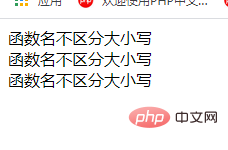How to play with PHP custom functions (summary sharing)
In the previous article, I brought you "How to use the For loop and Foreach loop in PHP (detailed picture and text explanation)". This article introduces in detail how to use and To distinguish between PHP's for loop and foreach loop, this article will take a look at the custom functions in the basic syntax of PHP functions. Hope it helps everyone!

PHP custom functions
PHP has provided us with many powerful system functions, but this is far from meeting the needs of programmers. A custom function can be created according to development needs. Functions are executed by calling functions. An example of the basic syntax format of a custom function is as follows:
function 函数名 (参数1, 参数2, ..., 参数n){
函数中的功能体;
return 返回值;
}The above syntax format has the following characteristics:
The first line of each function is composed of three parts: the keyword declaring the function
function, the function name and the parameter list;Every custom function must start with function, that is, use function declaration;
Function can have return value or no return value;
A function cannot be defined twice, that is, the function cannot be overloaded;
When declaring a function, the parentheses "()" after the function name are also required. The parentheses contain a set of parameter lists. The parameters are the declared variables, and then the variables can be passed to the function when the function is called. The parameter list can be empty or have one or more parameters. Use commas to separate multiple parameters;
After the function is created, it will Likewise, you can call functions anywhere on the page.
<?php
function a(){
echo '这是一个函数示例';
}
a();
a();
a();
?>Output result:

Function name and variables The naming rules are the same, but the difference is: function names are not case-sensitive .
<?php
function ABC(){
echo '函数名不区分大小写<br />';
}
aBC();
AbC();
ABc();
?>Output result:

The function is still defined before it is defined It can be called later. That is, the function can be called anywhere.
<?php
a();
function a(){
$b = '好好学习';
$b .= '天天向上';
echo $b;
}
a();
?>Output result:

Function action execution module If there is a return, the code after the return will not be executed.
<?php
function a(){
echo "好好学习";
return;
echo "天天向上";
}
a();
?>Output result:

After the function execution is completed ,return can bring the value inside the function body out of the function body.
<?php
function a(){
$b = 1;
$c = 9;
$d = $b + $c;
//将$d的结果进行返回
return $d;
}
//调用a()这个函数,$b和$c相加的$d就会返回回来给到变量$e
$e = a();
//输出$e的结果
echo $e;
?>Output result:

Variables in the function body and outside the function body The variables have no relationship
<?php
//先在函数体前定义变量$a的值为10
$a = 10;
function demo( $a ){
//形参带入了函数体内,函数体内变量$a 改为了 50
$a = 50;
echo $a + $a;
}
//将函数体外的变量$a,传入变量的参数处(实际传入的参数,实参),显示出的结果为100
demo($a);
//此处$hello的值输出,依然为10
echo $a;
?>Output result:

The function cannot be overloaded
<?php
function a(){
}
function a(){
}
?>The output result will report an error, and the function cannot be overloaded.
Recommended learning: "PHP Video Tutorial"
The above is the detailed content of How to play with PHP custom functions (summary sharing). For more information, please follow other related articles on the PHP Chinese website!

Hot AI Tools

Undresser.AI Undress
AI-powered app for creating realistic nude photos

AI Clothes Remover
Online AI tool for removing clothes from photos.

Undress AI Tool
Undress images for free

Clothoff.io
AI clothes remover

AI Hentai Generator
Generate AI Hentai for free.

Hot Article

Hot Tools

Notepad++7.3.1
Easy-to-use and free code editor

SublimeText3 Chinese version
Chinese version, very easy to use

Zend Studio 13.0.1
Powerful PHP integrated development environment

Dreamweaver CS6
Visual web development tools

SublimeText3 Mac version
God-level code editing software (SublimeText3)

Hot Topics
 1378
1378
 52
52
 PHP 8.4 Installation and Upgrade guide for Ubuntu and Debian
Dec 24, 2024 pm 04:42 PM
PHP 8.4 Installation and Upgrade guide for Ubuntu and Debian
Dec 24, 2024 pm 04:42 PM
PHP 8.4 brings several new features, security improvements, and performance improvements with healthy amounts of feature deprecations and removals. This guide explains how to install PHP 8.4 or upgrade to PHP 8.4 on Ubuntu, Debian, or their derivati
 How To Set Up Visual Studio Code (VS Code) for PHP Development
Dec 20, 2024 am 11:31 AM
How To Set Up Visual Studio Code (VS Code) for PHP Development
Dec 20, 2024 am 11:31 AM
Visual Studio Code, also known as VS Code, is a free source code editor — or integrated development environment (IDE) — available for all major operating systems. With a large collection of extensions for many programming languages, VS Code can be c
 7 PHP Functions I Regret I Didn't Know Before
Nov 13, 2024 am 09:42 AM
7 PHP Functions I Regret I Didn't Know Before
Nov 13, 2024 am 09:42 AM
If you are an experienced PHP developer, you might have the feeling that you’ve been there and done that already.You have developed a significant number of applications, debugged millions of lines of code, and tweaked a bunch of scripts to achieve op
 How do you parse and process HTML/XML in PHP?
Feb 07, 2025 am 11:57 AM
How do you parse and process HTML/XML in PHP?
Feb 07, 2025 am 11:57 AM
This tutorial demonstrates how to efficiently process XML documents using PHP. XML (eXtensible Markup Language) is a versatile text-based markup language designed for both human readability and machine parsing. It's commonly used for data storage an
 Explain JSON Web Tokens (JWT) and their use case in PHP APIs.
Apr 05, 2025 am 12:04 AM
Explain JSON Web Tokens (JWT) and their use case in PHP APIs.
Apr 05, 2025 am 12:04 AM
JWT is an open standard based on JSON, used to securely transmit information between parties, mainly for identity authentication and information exchange. 1. JWT consists of three parts: Header, Payload and Signature. 2. The working principle of JWT includes three steps: generating JWT, verifying JWT and parsing Payload. 3. When using JWT for authentication in PHP, JWT can be generated and verified, and user role and permission information can be included in advanced usage. 4. Common errors include signature verification failure, token expiration, and payload oversized. Debugging skills include using debugging tools and logging. 5. Performance optimization and best practices include using appropriate signature algorithms, setting validity periods reasonably,
 PHP Program to Count Vowels in a String
Feb 07, 2025 pm 12:12 PM
PHP Program to Count Vowels in a String
Feb 07, 2025 pm 12:12 PM
A string is a sequence of characters, including letters, numbers, and symbols. This tutorial will learn how to calculate the number of vowels in a given string in PHP using different methods. The vowels in English are a, e, i, o, u, and they can be uppercase or lowercase. What is a vowel? Vowels are alphabetic characters that represent a specific pronunciation. There are five vowels in English, including uppercase and lowercase: a, e, i, o, u Example 1 Input: String = "Tutorialspoint" Output: 6 explain The vowels in the string "Tutorialspoint" are u, o, i, a, o, i. There are 6 yuan in total
 Explain late static binding in PHP (static::).
Apr 03, 2025 am 12:04 AM
Explain late static binding in PHP (static::).
Apr 03, 2025 am 12:04 AM
Static binding (static::) implements late static binding (LSB) in PHP, allowing calling classes to be referenced in static contexts rather than defining classes. 1) The parsing process is performed at runtime, 2) Look up the call class in the inheritance relationship, 3) It may bring performance overhead.
 What are PHP magic methods (__construct, __destruct, __call, __get, __set, etc.) and provide use cases?
Apr 03, 2025 am 12:03 AM
What are PHP magic methods (__construct, __destruct, __call, __get, __set, etc.) and provide use cases?
Apr 03, 2025 am 12:03 AM
What are the magic methods of PHP? PHP's magic methods include: 1.\_\_construct, used to initialize objects; 2.\_\_destruct, used to clean up resources; 3.\_\_call, handle non-existent method calls; 4.\_\_get, implement dynamic attribute access; 5.\_\_set, implement dynamic attribute settings. These methods are automatically called in certain situations, improving code flexibility and efficiency.




